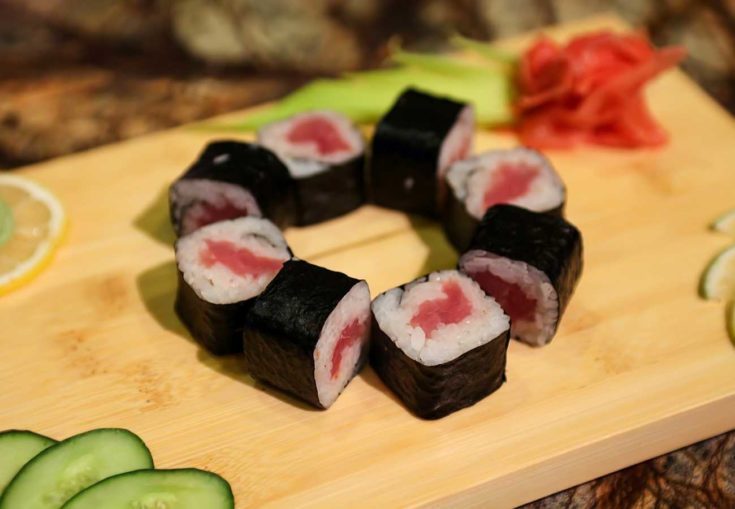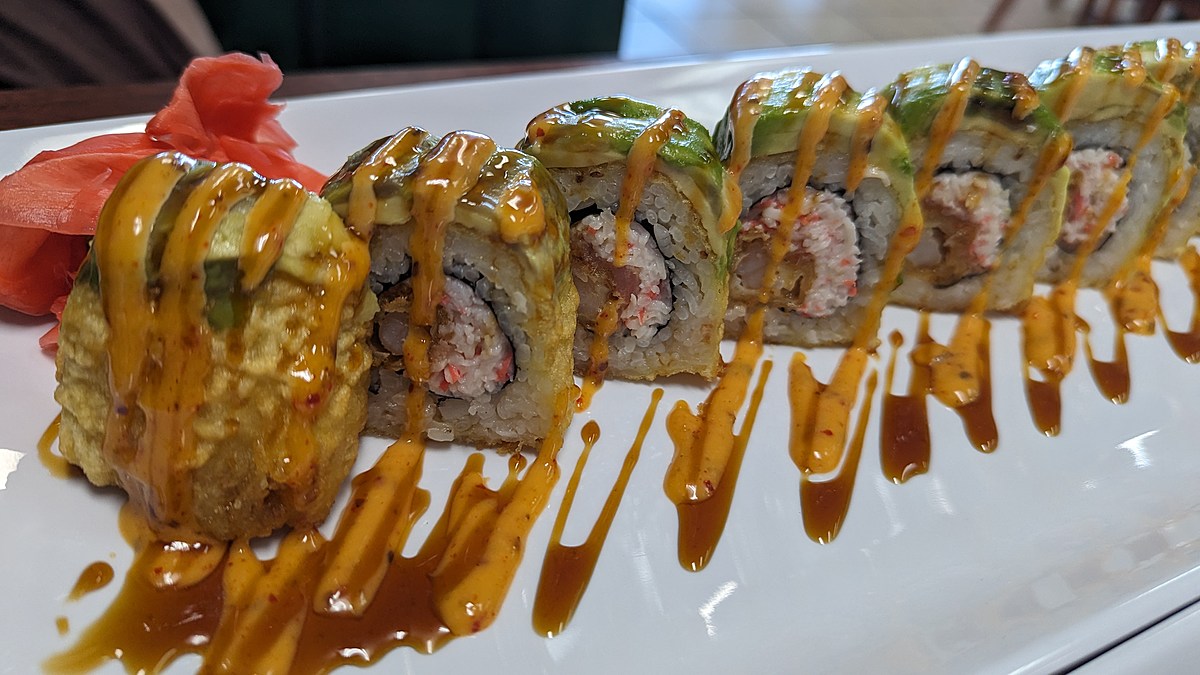
Introduction
Bluefin tuna’s journey from the Atlantic waters to the sushi bars of Tokyo is a remarkable example of globalization. In Sasha Issenberg’s book, “The Sushi Economy,” he explores how taste, technology, and market dynamics play a significant role in this process. This blog post will delve into the history of tuna in sushi and discuss the popularity of tuna sushi.
History Of Tuna In Sushi
- Tuna has been a staple in Japanese cuisine for centuries.
- Initially, it was mainly consumed salted or dried.
- With the introduction of sushi as a finger food in the early 19th century, the use of fresh tuna became more prevalent.
- The market for tuna expanded as refrigeration techniques improved, allowing for longer distances to be traveled in the supply chain.
- Fishermen began specifically targeting bluefin tuna due to its delectable taste and high market demand.
Popularity Of Tuna Sushi
- Tuna sushi has become one of the most sought-after dishes in sushi bars around the world.
- The rich, fatty texture and mild flavor of bluefin tuna are highly appealing to sushi enthusiasts.
- The demand for bluefin tuna has surged, leading to concerns about overfishing and the impact on the species’ population.
- Despite its high price and sustainability concerns, the popularity of bluefin tuna sushi remains strong in high-end restaurants and sushi establishments.
- Chefs and consumers are becoming more conscious about sustainable sourcing and are exploring alternatives such as farmed tuna or other fish options for their sushi creations.
In conclusion, the journey of bluefin tuna from the Atlantic to the sushi bars of Tokyo exemplifies the interconnectedness of global markets and the power of consumer preferences. The history and popularity of tuna in sushi highlight how taste, technology, and market demands drive the sushi economy. As awareness about sustainability grows, the future of tuna in sushi may involve exploring new options or finding ways to balance the demand for this delicacy with the need for conservation.
Types Of Tuna
Different Varieties Of Tuna Used In Sushi
- Skipjack Tuna
- Albacore Tuna
- Yellowfin Tuna
- Bigeye Tuna
- Bluefin Tuna
Tuna Grades And Quality
Each type of tuna has its own unique characteristics in terms of meat texture, color, and taste. This makes certain species more suitable for specific dishes, such as salads, steaks, or sushi.
Popular Tuna Species For Sushi
- Pacific and Atlantic Bluefin Tuna
- Southern Bluefin Tuna
- Bigeye Tuna
- Yellowfin Tuna
Tuna Preferences
Whether it is for sushi or other dishes, everyone has their favorite tuna species. Share your favorite tuna to eat and which tuna dish you would like to try next in the comments below.
Health Considerations
Nutritional Benefits Of Tuna
Tuna is a nutrient-dense protein that offers several health benefits. It is an excellent source of omega-3 fatty acids, which are essential for heart health and brain function. Omega-3s help reduce inflammation in the body and are also important for eye health. Tuna is also packed with high-quality protein, which is essential for muscle growth and repair. Additionally, it contains a variety of vitamins and minerals, including vitamin B12, selenium, and niacin.
Mercury Levels In Tuna
One important consideration when consuming tuna is its mercury content. Mercury is a toxic heavy metal that can accumulate in fish and have adverse effects on human health. Certain species of tuna, such as bluefin and bigeye, tend to have higher mercury levels than others. This is because larger fish that are higher up in the food chain accumulate more mercury over their lifespan. Mercury can be harmful to the nervous system, particularly in developing fetuses and young children.
It’s important to note that the FDA and EPA provide guidelines for safe consumption of fish, including tuna, specifically for pregnant women, breastfeeding mothers, and young children. These guidelines recommend limiting the intake of certain types of fish, including those with higher mercury levels.
In conclusion, tuna is a versatile and nutritious protein option. It offers a range of health benefits, but it’s important to consider the mercury levels when making choices about consuming tuna. Choosing smaller tuna species or opting for other types of seafood with lower mercury content can be a safer option. As with any food, moderation is key to maintaining a balanced and healthy diet.

Health Considerations
Tekka Maki (tuna Roll)
Tuna is a popular ingredient in traditional Japanese sushi rolls, particularly in the Tekka Maki or Tuna Roll. While this sushi roll is delicious and satisfying, it also offers several health benefits. Tuna is a nutrient-dense protein that is rich in omega-3 fatty acids, which are essential for heart health and brain function. These fatty acids help reduce inflammation in the body and promote good eye health. Tuna is also an excellent source of high-quality protein, necessary for muscle growth and repair. It contains important vitamins and minerals, including vitamin B12, selenium, and niacin.
Negitoro Maki (minced Tuna Roll)
Another popular sushi roll made from tuna is the Negitoro Maki or Minced Tuna Roll. This roll is made from minced Sashimi-Grade tuna, known as Negitoro. Similar to Tekka Maki, Negitoro Maki also provides numerous health benefits. The minced tuna is still a great source of omega-3 fatty acids and high-quality protein. It also contains vitamins and minerals that support overall health.
While tuna sushi rolls have their nutritional benefits, it’s important to be aware of the mercury content in tuna. Mercury is a toxic heavy metal that can accumulate in fish and have adverse effects on human health. Certain species of tuna, such as bluefin and bigeye, tend to have higher mercury levels than others. Larger fish higher up in the food chain accumulate more mercury over their lifespan. The FDA and EPA provide guidelines for safe fish consumption, especially for pregnant women, breastfeeding mothers, and young children, recommending limits on certain types of fish with higher mercury levels.
To enjoy the nutritional benefits of tuna while minimizing mercury exposure, choosing smaller tuna species or opting for other types of seafood with lower mercury content can be a safer option. It’s always essential to practice moderation and maintain a balanced and healthy diet. By considering these health considerations, you can continue to enjoy traditional tuna sushi rolls as part of a nutritious and delicious Japanese cuisine experience.
Creative Tuna Sushi Creations
Spicy Tuna Roll
The Spicy Tuna Roll is a classic and beloved sushi choice. While traditionally made with fresh tuna, there is no reason why you can’t get creative and substitute with canned tuna. The spicy tuna mixture and the rolling technique are open to interpretation and creativity, allowing you to experiment with different flavors and textures. Here are some ideas for substitutions when making a Spicy Tuna Roll with canned tuna:
- Spice it up: Add some heat by incorporating sriracha sauce or chili flakes into the tuna mixture. You can adjust the level of spiciness to your liking.
- Creamy twist: Mix in some mayonnaise or Greek yogurt to create a creamier filling. This adds a touch of richness and balances out the spiciness.
- Crunch factor: Add some crunch by including sliced cucumbers, julienned carrots, or crispy onions in the roll. These ingredients provide texture and enhance the overall eating experience.
Tuna Avocado Roll
Another creative way to enjoy tuna in sushi is by making a Tuna Avocado Roll. Avocado adds a creamy and buttery element that pairs beautifully with the tuna. Here’s how you can make this delicious variation:
- Mash it up: Mash the canned tuna with ripe avocado to create a flavorful filling. The creaminess of the avocado complements the tuna perfectly.
- The green touch: Add some freshness by including thinly sliced cucumber and lettuce leaves in the roll. These ingredients add a refreshing crunch and balance out the richness.
- Soy sauce dip: Serve the Tuna Avocado Roll with a side of soy sauce for dipping. The salty and savory flavors of the soy sauce enhance the taste of the roll.
These creative tuna sushi creations allow you to enjoy the flavors of traditional sushi while using canned tuna as a convenient and affordable alternative. Whether you prefer the spiciness of the Spicy Tuna Roll or the creaminess of the Tuna Avocado Roll, these variations offer a delicious and satisfying sushi experience at home. Remember to choose smaller tuna species to minimize mercury exposure and always practice moderation for a balanced and healthy diet.
Sustainability Concerns
Tuna Fishing Practices
The most typical species served as maguro in sushi is yellowfin tuna. While yellowfin tuna has a relatively good sustainability pedigree, there are concerns about the fishing practices used to catch it. The use of longline fishing or purse seine nets can have significant negative impacts on other marine species, such as dolphins and sea turtles, which can become unintentional bycatch. These fishing methods also have the potential to overfish tuna populations if not properly managed.
Sustainable Alternatives To Tuna
Given the sustainability concerns surrounding the consumption of tuna, it is important to consider alternative options when enjoying sushi. Some sustainable alternatives to tuna include:
- Hawaiian kampachi: This fish is a great alternative to yellowfin tuna and has a similar flavor and texture. Hawaiian kampachi is farmed using sustainable practices and is a more environmentally friendly choice.
- Atlantic albacore: Albacore tuna from the Atlantic Ocean is another sustainable option. It is typically smaller in size compared to other tuna species and has a milder flavor.
- Verlasso salmon: This salmon variety from Chile is raised using responsible aquaculture practices. It is a good alternative to other overfished salmon species.
By choosing these sustainable alternatives, you can still enjoy delicious sushi while supporting responsible fishing practices and helping to conserve vulnerable marine ecosystems.
In conclusion, while traditional maguro sushi made with yellowfin tuna is popular, it is important to consider the sustainability concerns associated with its consumption. By opting for sustainable alternatives and supporting responsible fishing practices, we can enjoy sushi while minimizing our impact on the oceans.

Tuna Sushi At Sushi Restaurants
Tuna Sushi Offerings At Popular Sushi Restaurants
When dining at a sushi restaurant, you will often find a variety of tuna sushi options on the menu. While the traditional maguro sushi made with yellowfin tuna is a popular choice, there are other tuna sushi rolls you can explore. Some popular tuna sushi rolls include:
- Spicy Tuna Roll: This roll features a combination of chopped tuna mixed with spicy mayo and other seasonings, giving it a flavorful kick.
- Tuna Avocado Roll: This roll combines fresh tuna and creamy avocado, offering a textural contrast and a rich taste.
- Tuna Cucumber Roll: This simple yet refreshing roll consists of sliced tuna and crisp cucumber, perfect for those looking for a light option.
Tuna Sushi Etiquette
When ordering tuna sushi at a sushi restaurant, it’s important to be aware of the following sushi etiquette:
- Eat sushi in one bite: Sushi is traditionally meant to be enjoyed in one bite, so try to avoid taking multiple bites or splitting the sushi roll into smaller pieces.
- Use chopsticks or fingers: It is acceptable to eat sushi with either chopsticks or your fingers. If you choose to use chopsticks, make sure to use them properly and not to spear the sushi.
- Dip sushi lightly in soy sauce: When dipping sushi in soy sauce, dip only the fish side to avoid the rice from getting too soggy. It is also polite to avoid adding too much soy sauce, as it can overpower the delicate flavors of the tuna.
By understanding the different tuna sushi offerings available at sushi restaurants and adhering to sushi etiquette, you can have a more enjoyable and knowledgeable experience when ordering tuna sushi. Whether you choose the traditional maguro sushi or explore other unique tuna sushi rolls, remember to savor each bite and appreciate the artistry and flavors of this popular sushi ingredient.
Homemade Tuna Sushi Recipes
Step-by-step Guide To Making Tuna Sushi At Home
Making your own tuna sushi rolls at home is easier than you may think. Here is a step-by-step guide to help you create delicious sushi right in your own kitchen:
- Prepare the sushi rice: Start by cooking sushi rice according to the package instructions. Once cooked, let it cool slightly and then season with rice vinegar and a pinch of salt.
- Prepare the ingredients: Slice fresh tuna into thin strips and prepare other ingredients such as cucumber, avocado, and nori sheets.
- Assemble the sushi rolls: Lay a sheet of nori on a bamboo sushi mat and evenly spread a layer of sushi rice on top. Leave about an inch at the top and bottom edges of the nori sheet uncovered. Arrange the tuna, cucumber, and avocado along the center of the rice.
- Roll it up: Use the bamboo mat to tightly roll the sushi, using a bit of pressure to ensure it holds its shape. Moisten the uncovered edge of the nori sheet with a bit of water to help seal the roll.
- Slice and serve: Use a sharp knife to slice the sushi roll into bite-sized pieces. Serve with soy sauce, wasabi, and pickled ginger for dipping.
Tips For Buying And Preparing Fresh Tuna
When making tuna sushi, it’s important to choose fresh and high-quality tuna for the best flavor and texture. Here are some tips:
| Tips for Buying Fresh Tuna | Tips for Preparing Fresh Tuna |
|---|---|
| Look for bright red flesh with a firm texture. | Remove any skin or bones from the tuna before slicing. |
| Buy from a reputable fishmonger or a trusted source. | Chill the tuna in the refrigerator before slicing to make it easier to work with. |
| Ask the fishmonger about the origin and freshness of the tuna. | Use a sharp knife to slice the tuna against the grain for the best texture. |
| Use your senses to check for any off odors or sliminess. | Keep the sliced tuna refrigerated until ready to use to maintain freshness. |
By following these steps and tips, you can easily create delicious and fresh homemade tuna sushi rolls. Whether you’re making it for yourself or with your kids, enjoy the process and savor the flavors of your homemade sushi creation.
Conclusion
The Love For Tuna Sushi
Tuna sushi is a beloved dish that is enjoyed by sushi enthusiasts all over the world. The traditional hosomaki style tuna roll is a classic choice, featuring fresh strips of tuna alongside other ingredients like cucumber and avocado. Making tuna sushi at home is a fun and satisfying experience, and it’s easier than you may think. By following a step-by-step guide, you can create delicious sushi rolls right in your own kitchen. The key is to use high-quality and fresh ingredients, especially when it comes to the tuna. Choosing bright red flesh with a firm texture and buying from a reputable source ensures the best flavor and quality. Additionally, properly preparing the tuna by removing any skin or bones and slicing it against the grain enhances the texture of the sushi roll. By utilizing these tips, you can enjoy the flavors of homemade tuna sushi any time you crave it.
Exploring Tuna Sushi Beyond Tradition
While the traditional hosomaki style tuna roll is a favorite among sushi lovers, there are various other ways to enjoy tuna in sushi. Some popular alternatives include nigiri sushi, where a slice of tuna is placed on a small ball of sushi rice, or sashimi, where thinly sliced tuna is served without rice. These options allow the flavor and texture of the tuna to shine through, providing a different experience for those who want to explore beyond the traditional tuna roll. Whether you prefer the classic hosomaki or want to try new variations, the love for tuna sushi is undeniable. However, it’s important to consider the impact of excessive tuna fishing on the environment, particularly the endangered bluefin tuna. Moving forward, it’s crucial to prioritize sustainable fishing practices and make conscious choices when it comes to seafood consumption. By enjoying tuna sushi responsibly, we can continue to appreciate this beloved delicacy while preserving the oceans for future generations.
Tuna Tales in Sushi Adventures FAQ
Q1: What is Tuna Tales in Sushi Adventures?
Tuna Tales in Sushi Adventures is a collection of exciting and mouthwatering tales that revolve around the delightful world of sushi, with a special focus on can tuna sushi. It is a book that combines creative storytelling with the deliciousness of sushi, bringing you on a unique and adventurous journey.
Q2: Who is the author of Tuna Tales in Sushi Adventures?
Tuna Tales in Sushi Adventures is written by acclaimed author and sushi enthusiast, who has a deep passion for both storytelling and culinary experiences. With their expertise in both fields, they have crafted a captivating book that embodies the joy and wonder of sushi through imaginative tales.
Q3: What can I expect from Tuna Tales in Sushi Adventures?
When you dive into Tuna Tales in Sushi Adventures, you can expect to be transported into a world filled with delectable flavors and captivating stories. Each tale has a different theme that explores the fascinating origins, cultural influences, and culinary journeys of can tuna sushi. It is a book that not only satisfies your literary cravings but also ignites a desire to indulge in sushi.
Q4: Is Tuna Tales in Sushi Adventures suitable for all ages?
Yes, Tuna Tales in Sushi Adventures is suitable for readers of all ages. The stories are written in a friendly and engaging tone that can be enjoyed by both children and adults. It is a book that brings together the joy of storytelling and the love for sushi, making it a perfect choice for families or anyone with an appetite for adventure.
Q5: Are there any recipes included in Tuna Tales in Sushi Adventures?
While Tuna Tales in Sushi Adventures primarily focuses on storytelling, it also includes a section that features some mouthwatering recipes related to can tuna sushi. These recipes can be easily followed by readers who would like to try their hand at creating their own sushi masterpieces. It adds the perfect culinary touch to the overall experience of the book.
Q6: Where can I purchase Tuna Tales in Sushi Adventures?
Tuna Tales in Sushi Adventures is available for purchase online through various platforms, including online bookstores and e-retailers. You can also check with your local bookstores to see if they carry copies of the book. Keep an eye out for special promotions or discounts that may be available to make your purchase even more enjoyable.
Embark on a delightful journey with Tuna Tales in Sushi Adventures and let your imagination run wild with the flavors of can tuna sushi. Whether you are a sushi connoisseur or simply a lover of good stories, this book promises to satisfy both your literary cravings and your taste buds.

Our restaurant focuses on providing fresh, new, and cultural dishes to satisfy our customers! All of our dishes are made with the freshest ingredients and with the highest quality spices. We mainly focus on our presentation as well as our flavors. Our main ingredients are fresh meat, seafood, fruits, and vegetables. Some of our Chinese dishes are more raw and pure, while others are sour and spicy. It all depends on what you enjoy; we have it all.
